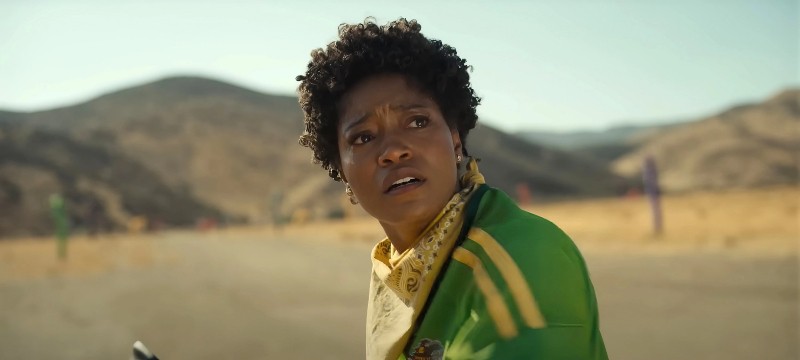Writer-director Jordan Peele‘s (Get Out, Us) status as one of the great American filmmakers of recent years reaches new heights with Nope, a science fiction-horror-western film so visually and thematically rich that viewers need not worry about having too little to talk about afterwards. Peele brings his comedic chops, palpable cinephilia, and an endlessly compatible cast together in a soft, often quiet tale that marks a clear development of his craft. Everyone will find something to appreciate about Nope.
To give you a sense of Nope’s thematic scope, the film touches upon contemporary UFO (or UAP) sightings, the development of cinema technology, the nature of the photograph and moving image, family dynamics, viral culture, childhood trauma, animal exploitation, and much, much more. Peele navigates each of these like a plate spinner, spending just enough time to intrigue and satisfy the audience before moving on to the next. All 135-minutes, marking Peele’s longest film to date, seem to fly by.
Much of the film’s success can be found in its leads, Daniel Kaluuya and Keke Palmer. The two play OJ and Emerald Haywood, a brother and sister who unexpectedly assume responsibility of their family’s ranch. One night, OJ spots a UFO flying above the mountains. The two then partner to film the craft in the hope that they can sell the video. They enlist Angel Torres (Brandon Perea), who works at the local tech store, to help them set up cameras. Naturally, all does not go to plan.
The on screen chemistry between Kaluuya and Palmer is unlike any other relationship we have seen in a Peele film before. Kaluuya offers a strong, subdued performance. Each word feels deliberate and complements Peele’s use of silence throughout the film. Often, the camera lingers on Kaluuya as he watches, thinks, and rides, and hopefully this won’t be the last time we see him on horseback. Palmer’s “Em” marks a charismatic contrast as she brings the energy and many of the film’s best one-liners. One of the great joys of the film is watching the two come together, meeting each on the other’s level.
Peele pairs the happenings at the Haywood Ranch with a nearby rodeo theme park run by Ricky “Jupe” Park (Steven Yeun). Jupe, a former child actor, draws people to his business with the promise of tales from his past. The story most want to hear is that of an animal-casting gone violently wrong on the set of his canceled TV show. Jupe’s tale compliments the film’s broader themes well, but at times feels like an unneeded deviation away from the main action. One cannot help but wish they were spending more time with Em and OJ. However, Yeun delivers a strong performance in the limited role. Not to mention one of the film’s most uniquely horrifying scenes occurs at the park.
And that is the thing about Nope. While Peele so expertly deals in genre and pays homage to that which came before him, viewers are likely to encounter images and sounds they never have before. Peele and cinematographer Hoyte van Hoytema capture it all with their cameras, from beautiful landscape shots to intimate close-ups in the textured darkness of the night. Nope show’s Peele’s virtuosic command of filmmaking, and it’s a joy to feel one’s eyes be so expertly guided.
The film’s sound design deserves particular attention. Sounds shoot across the night sky, through mountainous valleys, and around the ranch. And as previously mentioned, Nope does not shy away from silence. There are times when the audience is left to just left to sit with the crickets and the wind. One’s ears becomes just as immersed in Peele’s world as the eyes.
One of the film’s key themes is the moving image’s impact on human perception. At the outset of Nope, Em explains that she and her brother are descendants of the Black man who road the horse in Eadweard Muybridge’s The Horse in Motion (1878), one of the first moving images. When they stumble into the UFO business, they, in a way, come to embody contemporary images in the same way that their ancestor did more than one hundred years before. Film has given Em and OJ the chance to get rich, but its continued development has made it so they need the perfect, totally-believable image. “That’s good, but it ain’t it,” they say at one point. “It ain’t Oprah good.” And to get Oprah-good, they must keep putting themselves in danger. The moving image becomes both a blessing and a curse.
Understandably, so much of contemporary moviemaking concerns itself with the digital image’s hold over society: social media, the pursuit of viral fame, smartphone usage, etc. So often, films beat us over the head with these themes and “critiques.” Thankfully, no unnecessary montages of TikTok videos, for example, are found in Peele’s work. Instead, these questions come to inform the thematic fabric of the story without calling too much attention to itself. Never does it feel overly gratuitous.
In telling her great-great-great-grandfather’s story, Em refers to him as the first movie star. What follows is a film about Em and her brother pursuing fame by way of filming themselves and non-human life. Are Em and OJ too concerned with acquiring fame and wealth? Or are they simply just seeking that which their great-great-great-grandfather never got but deserved?
Nope opens in theaters on July 22, 2022

